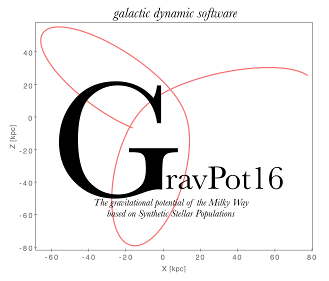This web service allows to compute orbits for any given star, knowing its present position and 3D velocities. It is based on a Galactic gravitational potential driven by the Besançon Galaxy Model mass distribution. The details of the computation of this non-axisymmetric model are presented in Jose G. Fernandez-Trincado PhD thesis (2017). It includes a prolate bar potential which is close to the bar model described in Robin et al (2012) A&A 535, A106. This potential has already been used for orbit computations in a number of publications (see below).
Default parameters are the values taken in paper of the Gaia collaboration Helmi et al. (2018),A&A, 616, A12: Gaia Data Release 2. Kinematics of globular clusters and dwarf galaxies around the Milky Way. Users can instead use their own parameters for the bar, solar motion, Sun position, etc., as they want.
Input parameters for the objects for which to integrate orbit:
- Positions in equatorial coordinates (RA, DEC), equinoxe J2000
- Radial velocities in km/s
- Proper motions (pmRa*cos(dec), pmDec) in mas/yr
- Distance in kpc
- Errors can be given on each of these parameters. For the time being errors should be set to 0. In the future we plan to use errors for Monte Carlo computations, when more resources are available.
Input parameters for the Galaxy model:
- Bar mass (solar mass)
- Bar angle (degre)
- Bar pattern speed (km/s/kpc)
- R0, z0 Sun position (kpc)
- U0, V0, W0 Sun velocities (km/s)
- ULSR,VLSR,WLSR Velocities of the LSR (km/s)
Input parameters for the characteristics of the integration
- Integration time (Gyr)
- Orbit integration forward (+1) or backward (-1)
- Tolerance in the integration (between 1.d6 and 1.d13)
The service provides 2 output files. The first contains the following parameters for the portion of orbit computed for the given integration time. Coordinates are given in the referential system of the Galaxy (*_inert) and in the referential of the bar (*_bar). Units are Gyr for time, kpc for distances and km/s for velocities:
- Total integration time Int_Time in Gyr
- Id
- mean X_inert
- mean Y_inert
- mean Z_inert
- mean Vx_inert
- mean Vy_inert
- mean Vz_inert
- mean X_bar
- mean Y_bar
- mean Z_bar
- mean Vx_bar
- mean Vy_bar
- mean Vz_bar
- mean Jacobi energy EJ
- maximum X orbital distance from the galactic center in units of kpc
- maximum Y orbital distance from the galactic center in units of kpc
- maximum Z orbital distance from the galactic center in units of kpc
- R_apo apocenter distance in units of kpc
- R_peri pericenter distance
- E_max maximum total orbital energy in units of km^2 s^{-2]
- E_min minimal total orbital energy in units of km^2 s^{-2]
- Eccentricity defined as: e = (r_apo - r_peri) / (r_apo + r_peri), from two successive maximum and minimum orbital points, i.e, apo-galacticon (r_apo) and peri-galacticon (r_peri), where r = sqrt( X^2 + Y^2)
- Lz mean angular momentum
- Incl computed as acos(Lz/Ltot)
- Phil computed as atan2(Ly,Lx)
- Period (when it exists) in Gyr
- Time since last apocenter Ta in Gyr
- Time since last pericenter Tp in Gyr
The second file contains the orbit and values at a given time along the orbit. Coordinates are given in the referential system of the Galaxy (columns 3 to 8) and in the referential of the bar (columns 9 to 14):
- Column 1: t integration time in Gyr
- Column 2: Id
- Column 3: X in the inertial reference frame in units of kpc
- Column 4: Y in the inertial reference frame in units of kpc
- Column 5: Z in the inertial reference frame in units of kpc
- Column 6: Vx in the inertial reference frame in units of km/s
- Column 7: Vy in the inertial reference frame in units of km/s
- Column 8: Vz in the inertial reference frame in units of km/s
- Column 9: X in the non-inertial reference frame in units of kpc
- Column 10: Y in the non-inertial reference frame in units of kpc
- Column 11: Z in the non-inertial reference frame in units of kpc
- Column 12: Vx in the non-inertial reference frame in units of km/s
- Column 13: Vy in the non-inertial reference frame in units of km/s
- Column 14: Vz in the non-inertial reference frame in units of km/s
- Column 15: E_J Jacobi energy in units of 100 km^2 s^{-2} in the non-inertial reference
- Column 15: E_tot total energy
- Column 16: L_z the angular momentum
- Column 17: L_tot the total momentum
- Column 18: Incl the inclination of the orbit in degres
- Column 19: Phil the angle of the orbit
- Column 20: Pot Total potential at the time t
- Column 21: PotBar Potential of the bar at time t
We also give 2 images showing the orbit computed, points color-coded with the time, on the 3 projections XY, YZ, XZ.
You can access the form using the javascript client (on this page) or directly access to parameters in web service mode (a sample Python client program for using the web service can be downloaded).
Disclaimer
Simulations are made at your own risks. The authors are not responsible for wrong applications of their model.
In case you would like complementary informations, you may contact the authors directly (modele[at]obs-besancon.fr).
